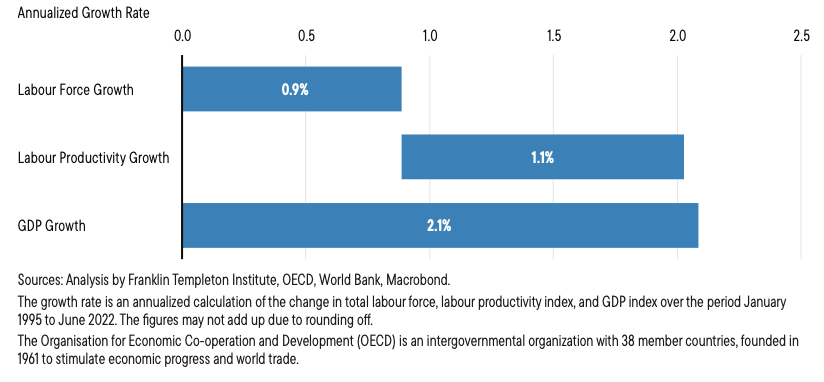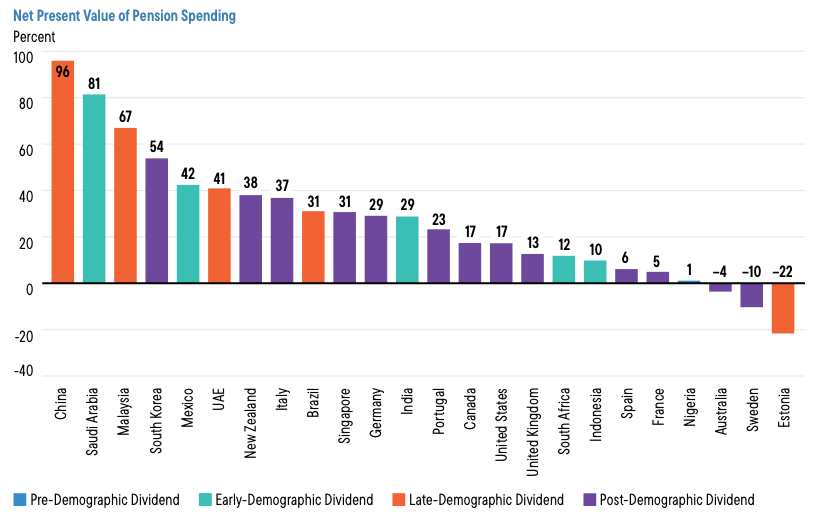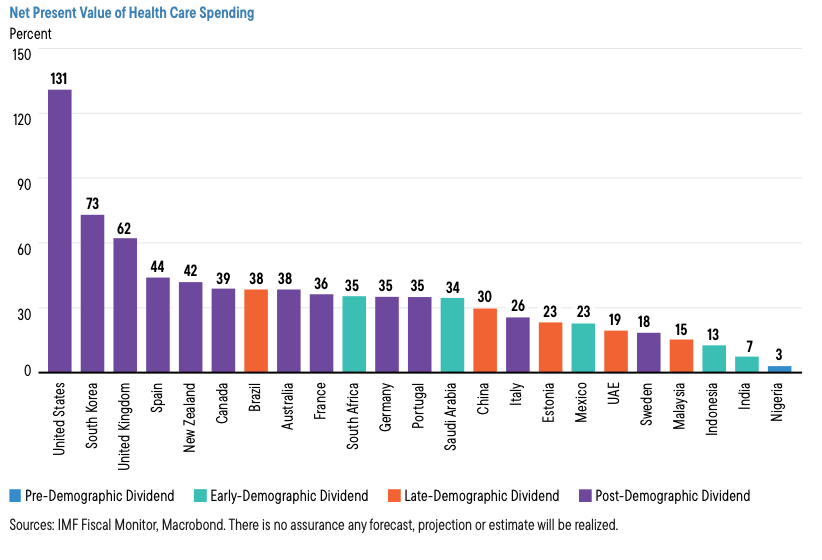A version of this article, authored by Kim Catechis, Investment Strategist at Franklin Templeton Investment Institute, first appeared in The Bulletin: Demographics and long-term growth. OMFIF, Summer 2023.
Demographics as a driver of economic growth
Conventional wisdom points to young demographics as a driver of economic growth.
The thesis is that young populations indicate a growing labor force, suggesting productivity gains long into the future. The reality is more complicated.
Having a lot of young people is clearly good, but they need to be healthy enough to work and able to learn appropriate skills for the labor market. We don’t need millions of Ph.D.s, but rather, a relatively well-educated pool of young people, because they are more easily employable. Given the trend toward automation and artificial intelligence (AI), the growth of the “knowledge” economy drives demand for skilled workers. A young, well- educated labor force will attract investment in high-margin, productive areas, providing the positive driver for economic growth.
The countries that have driven global economic growth in the last generation are those with aging populations, which likely will result in slower economic growth in the future. Even though many individuals are working beyond the typical retirement age, working age-populations are shrinking. As the pension-age cohort increases, governments will try to find solutions to the anticipated slowdown in economic growth. Exhibit 1 on the next page demonstrates the importance of net labor-force growth as a contributor to gross domestic product (GDP) growth.
Demographics is also an important driver of debt issuance—
and of ratings
A wave of liabilities is growing around the world, as aging populations imply significantly higher healthcare and pension costs. It is not about the number of young people; it is policy direction that matters. Governments that implement policies to encourage savings for pensions and invest in healthcare provision are less likely to be challenged.
Exhibit 2, on the next page, illustrates the incremental cost of pension and healthcare provision up to 2050, expressed as a percentage of 2021 GDP. The colors denote each country’s position away from that optimum point of “demographic dividend1:”
Exhibit 1: Contributors to Annualized GDP Growth of OECD Countries
January 1995–June 2022

Exhibit 2: The Economic and Fiscal Impact of Aging Populations
2021–2050 Estimated Change as Percent of GDP
October 2022


“Early demographic dividend” countries also risk significant growth in liabilities in the next generation. Saudi Arabia for example, has a relatively young population, and needs to finance the equivalent of over 115% of 2021 GDP by 2050. China, a giant economy with a shrinking population, has a liability of 120% of 2021 GDP. The impact of policymaking is very clear in the few countries in this selection that have essentially overfunded their pension obligations. They include Estonia, Denmark, Sweden and Australia.
The role of demographics in country credit ratings
France recently suffered a credit-rating downgrade amid the struggle to raise the retirement age by two years, to 64. The rationale for the downgrade rests on the inconvenient truth that even a single percentage-point increase in borrowing costs has a compounding effect over a decade, resulting in significant growth of the debt burden. The conclusion, however, is that any government’s visible difficulty in enacting reforms bodes poorly for the prospects of a course correction to avoid further difficulties in the future. Growing pressure on public finances demands reform of the extent of social service provisions and/or fiscal policy, to keep government finances sustainable.
Conclusion
The traditional view of demographics as a driver of economic growth is no longer appro- priate. Qualitative factors override this assumption. For aging countries, the challenge is primarily to ensure continuous improvement in educational standards, because their economies are becoming more knowledge and technology-driven. For “younger” countries, the challenge is similarly education-related, because they need to offer more than cheap unit-labor costs.
However, the global economic and geopolitical environment constrains policymakers’ options as businesses diversify supply chains and respond to incentives for investment, like the US government’s Inflation Reduction Act. This means that high-fertility countries cannot simply follow the old playbook of attracting foreign direct investment FDI into labor-intensive industries; they must try to leverage their mineral wealth or their strategic positioning instead.
Allowing for cultural and wealth disparities between countries, consumption patterns generally will change. This evolution of savings and investment will drive real interest rates, real exchange rates and even returns on investment. Demographics is not destiny, but it can set parameters.
1. The United Nations Population Fund definition holds that there is a demographic dividend, i.e., a period of accelerated economic growth that may occur when a country has a growing population of workers, because they are productive generators of economic wealth.
WHAT ARE THE RISKS?
All investments involve risks, including possible loss of principal.
This material is provided for informational purposes only and nothing herein constitutes investment, legal, accounting or tax advice. This material is general in nature and is not directed to any category of investors and should not be regarded as individualised, a recommendation, investment advice or a suggestion to engage in or refrain from any investment-related course of action. All information is current as of the date of this material and is subject to change without notice. Any views or opinions expressed may not reflect those of the firm or the firm as a whole. Franklin Templeton does not accept any responsibility to update any opinions or other information contained in this document. This material may include estimates, outlooks, projections and other ‘forward-looking statements’. Due to a variety of factors, actual events may differ significantly from those presented.
IMPORTANT LEGAL INFORMATION
This material is intended to be of general interest only and should not be construed as individual investment advice or a recommendation or solicitation to buy, sell or hold any security or to adopt any investment strategy. It does not constitute legal or tax advice. This material may not be reproduced, distributed or published without prior written permission from Franklin Templeton.
The views expressed are those of the investment manager and the comments, opinions and analyses are rendered as of the publication date and may change without notice. The underlying assumptions and these views are subject to change based on market and other conditions and may differ from other portfolio managers or of the firm as a whole. The information provided in this material is not intended as a complete analysis of every material fact regarding any country, region or market. There is no assurance that any prediction, projection or forecast on the economy, stock market, bond market or the economic trends of the markets will be realized. The value of investments and the income from them can go down as well as up and you may not get back the full amount that you invested. Past performance is not necessarily indicative nor a guarantee of future performance. All investments involve risks, including possible loss of principal.
Any research and analysis contained in this material has been procured by Franklin Templeton for its own purposes and may be acted upon in that connection and, as such, is provided to you incidentally. Data from third-party sources may have been used in the preparation of this material and Franklin Templeton (“FT”) has not independently verified, validated or audited such data. Although information has been obtained from sources that Franklin Templeton believes to be reliable, no guarantee can be given as to its accuracy and such information may be incomplete or condensed and may be subject to change at any time without notice. The mention of any individual securities should neither constitute nor be construed as a recommendation to purchase, hold or sell any securities, and the information provided regarding such individual securities (if any) is not a sufficient basis upon which to make an investment decision. FT accepts no liability whatsoever for any loss arising from use of this information and reliance upon the comments, opinions and analyses in the material is at the sole discretion of the user.
Products, services and information may not be available in all jurisdictions and are offered outside the U.S. by other FT affiliates and/or their distributors as local laws and regulation permits. Please consult your own financial professional or Franklin Templeton institutional contact for further information on availability of products and services in your jurisdiction.



